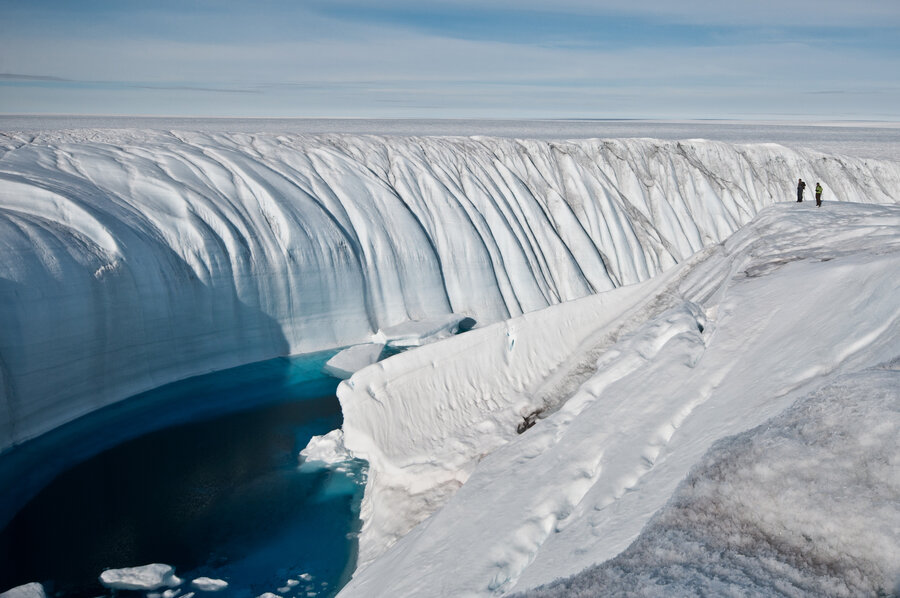Three lessons from that Antarctic ice study
Loading...
Research from retired NASA Goddard Space Flight Center scientist H. Jay Zwally made headlines this week for finding that – contrary to popular belief – Antarctica is gaining more ice than it’s losing ... for now.
But Dr. Zwally warned in a NASA announcement that, “It could take only a few decades for the ice melt in Antarctica to outweigh the ice gains.”
Zwally didn’t dispute that sea levels are rising, telling The Christian Science Monitor in an interview, it’s “definitive, there’s no question about that." But they’re not rising because of ice melt on Antarctica, he says.
In last week’s paper, Zwally, who is now affiliated with the Earth System Science Interdisciplinary Center at the University of Maryland in College Park, said his satellite and meteorological data analysis showed that overall Antarctic land ice has gained mass.
Much of Zwally’s latest analysis is based on data collected using a laser tool on a NASA satellite called the Ice, Cloud, and land Elevation Satellite (ICESat).
ICESat travels in the polar orbit with a laser shooting out pulses of light to measure how long it takes it to hit the Earth’s surface and bounce back. Over time, depending on how long it takes the light to travel to and from the same locations on Earth, ICESAt can tell how the elevation on land is changing.
But Zwally’s findings about land ice on the southern continent contradict previous research that has showed that Antarctica has lost ice overall, based on data collected from a NASA mission called Gravity Recovery and Climate Experiment (GRACE) of a pair of satellites that measure the tiny variations in the Earth’s gravity field to determine the amount and density of the mass below.
Some scientists, like Ted Scambos, senior researcher at the National Snow and Ice Data Center in Boulder, Colo., say that ICESat data is inaccurate.
“There’s no real way to reconcile this paper with the finding of half a dozen labs using the GRACE satellite, which consistently indicate that Antarctica is losing mass overall,” he points out in an e-mail to the Monitor.
Dr. Scambos points to studies that have found problems with ICESat, but says he has not read Dr. Zwally’s study.
More ice or less ice, here are a few important takeaways from the discussion:
1. Measuring land ice in Antarctica is hard
Scientists agree that none of the data-gathering tools are perfect. What they don’t agree on is which measurement tool – GRACE or ICESat – provides the most accurate data.
“You’re talking about a continental-size area and changes in centimeters and millimeters,” explains Thomas P. Wagner, a NASA climate scientist, in an interview with the Monitor.
“It’s very, very difficult to do this from space with a satellite, but one of the only ways to do it is by satellite,” he explains.
But scientists are constantly improving their tools and learning more about the ice sheets. NASA is launching a second-generation ICESat in 2018, with more and better lasers and detectors that will circle the globe and, for the first time, report real-time, continuous data collected over larger swaths of land. NASA also plans to upgrade GRACE.
2. Sea levels are rising
Sea levels are rising at double the rate (3.2 millimeters per year) of the 20th century, UN's Intergovernmental Panel on Climate Change (IPCC) says. And it’s “virtually certain” that this trend will continue for many centuries.
Up until this century, ice melt on land has made only a small impact on sea level rise. About two-thirds of it has come from thermal expansion, or ocean that’s heating up from a warmer climate and causing the water to expand, according to Julien P. Nicolas, an atmospheric scientist at Ohio State University.
But, “polar ice sheet and melting glaciers’ contribution is rapidly growing and we expect that in the 21st century might become most important source of sea level rise,” Dr. Nicolas, who was also a contributing author on sea level rise in the 2013 report from the IPCC, told the Monitor in an interview.
3. The globe is still warming
The IPCC, an organization of scientists from around the globe, says warming of the climate is “unequivocal” and that it is at least 95 percent certain that humans are the main cause. And if temperatures continue to rise unabated, says the group, it is “very likely” we’ll see increase in intensity and quantity of heat waves and extreme precipitation. The ocean, says the IPCC, will continue to warm and acidify, and sea level will continue to rise.







